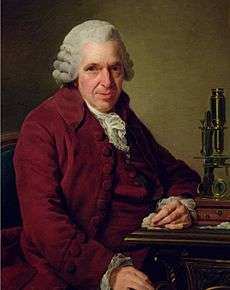Louis-Jean-Marie Daubenton
| Louis-Jean-Marie Daubenton | |
|---|---|
|
Louis-Jean-Marie Daubenton by Alexander Roslin | |
| Born |
29 May 1716 Montbard (Côte-d'Or) |
| Died | 1 January 1800 (aged 83) |
| Nationality | French |
| Fields | naturalist |
Louis-Jean-Marie Daubenton (29 May 1716 – 1 January 1800) was a French naturalist and contributor to the Encyclopédie ou Dictionnaire raisonné des sciences, des arts et des métiers.[1]
Biography
Daubenton was born at Montbard (Côte-d'Or). His father, Jean Daubenton, a notary, intended him for the church, and sent him to Paris to study theology, but Louis-Jean-Marie was more interested in medicine. Jean's death in 1736 set his son free to choose his own career, and in 1741 he graduated in medicine at Reims and returned to his hometown, planning to practice as a physician. At about this time, Georges-Louis Leclerc de Buffon, also a native of Montbard, was preparing to bring out a multi-volume work on natural history, the Histoire naturelle, générale et particulière, and in 1742 he invited Daubenton to assist him by providing anatomical descriptions. In many respects, the two men were complete opposites, but they worked well in partnership. In 1744, Daubenton became a member of the French Academy of Sciences as an adjunct botanist, and Buffon appointed him keeper and demonstrator of the king's cabinet in the Jardin du Roi.
In the first section of the Histoire naturelle, Daubenton gave descriptions and details of the dissection of 182 species of quadrupeds, thus securing himself a high reputation as a comparative anatomist. Concerned about the readability and profitability of the Histoire naturelle, Buffon dropped Daubenton's anatomical descriptions from later editions as well as from the series on birds, but Daubenton continued to work closely with Buffon at the Jardin du Roi.
Daubenton published many articles in the memoirs of the Parisian Académie Royale des Sciences, presenting his research on animals, the comparative anatomy of extant and fossil animals, vegetable physiology, mineralogy, agriculture, and the merino sheep that he successfully introduced into France. From 1775 onwards, Daubenton lectured on natural history in the College of Medicine, and in 1783 on rural economy at the Alfort school. He was also professor of mineralogy at the Jardin du Roi. As a lecturer he was in high repute, and to the last retained his popularity. In December 1799 he was appointed a member of the senate, but at the first meeting which he attended he fell from his seat in an apoplectic fit and, after a short illness, died at Paris.
Relatives
He is not to be confused with his cousin Edmé-Louis Daubenton, who was also a naturalist.
See also
Notes
References
- Gysel, C (1979), "[Daubenton (1716–1800) and his research on the occipital foramen]", L' Orthodontie française, 50, pp. 377–92, PMID 122116
- Farber, P L (1975), "Buffon and Daubenton: divergent traditions within the Histoire naturelle.", Isis; an international review devoted to the history of science and its cultural influences (published Mar 1975), 66 (231), pp. 63–74, PMID 1100562
- Attribution
 This article incorporates text from a publication now in the public domain: Chisholm, Hugh, ed. (1911). "Daubenton, Louis-Jean-Marie". Encyclopædia Britannica (11th ed.). Cambridge University Press.
This article incorporates text from a publication now in the public domain: Chisholm, Hugh, ed. (1911). "Daubenton, Louis-Jean-Marie". Encyclopædia Britannica (11th ed.). Cambridge University Press.
External links
 Media related to Louis-Jean-Marie Daubenton at Wikimedia Commons
Media related to Louis-Jean-Marie Daubenton at Wikimedia Commons
